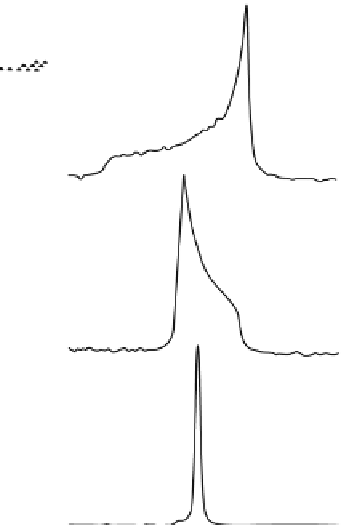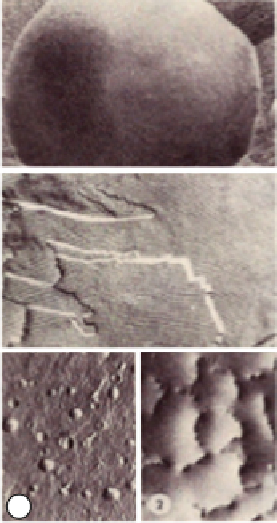Biology Reference
In-Depth Information
Corresponding
31
P-NMR spectra
Phospholipid phases
Corresponding Fracture-Faces
Bilayer
Hexagonal (H
II
)
Phases where
isotropic motion occurs
1. Vesicles
2. Inverted micellar
3. Micellar
4. Cubic
5. Rhombic
2
1
40 ppm
H
FIGURE 10.11
31
P-NMR spectra of lamellar (bilayer) phase, inverted hexagonal (H
II
) phase and other
(isotropic) phase. Left Column, membrane structure; Middle Column,
31
P-NMR spectra; Right Column, freeze
fracture electron micrograph
[19]
.
The pure soy PE vesicles produced a spectra indicating H
II
phase only (i.e. it had a low-field
peak and a high-field shoulder). As PC was added to the PE vesicles the H
II
phase spectra
started to diminish. By 15 mol% PC the major spectral component was a shoulderless peak,
indicating a transition state. Increasing levels of PC served to amplify the lamellar spectra.
By 50 mol% PC the spectra indicated only the presence of lamellar phase. Therefore it was
concluded that PC has a larger influence on lipid phase than does PE.
So we are still left with the same perplexing question. What is the biological function of
'lipid polymorphism'? After almost 4 billion years of chemical and biological evolution,
Nature would not produce something so profound without a very good reason. We are
just at the beginning of addressing this problem.
Table 10.3
lists some basic membrane lipids
and their preferred phase. It appears that cylindrical lipids prefer the lamellar phase, while
cone-shaped lipids prefer the H
II
(or non-lamellar) phase, and inverted cone-shaped lipids
prefer the micellar phase. Even this is complicated by the ability of a particular lipid to
have its preferred phase altered upon changes in its environment. For example, at pH 7 PS
and PA have a cylindrical shape and prefer the lamellar phase. However, if the pH is reduced
to less than 4, the head group negative charge is reduced, thus decreasing charge repulsion.
This reduces the apparent head group diameter (a
o
) without affecting the tail diameter (a
h
).
When reduced to pH 4, PS and PA switch from a cylindrical (lamellar) shape to a cone (H
II
)














































































































































